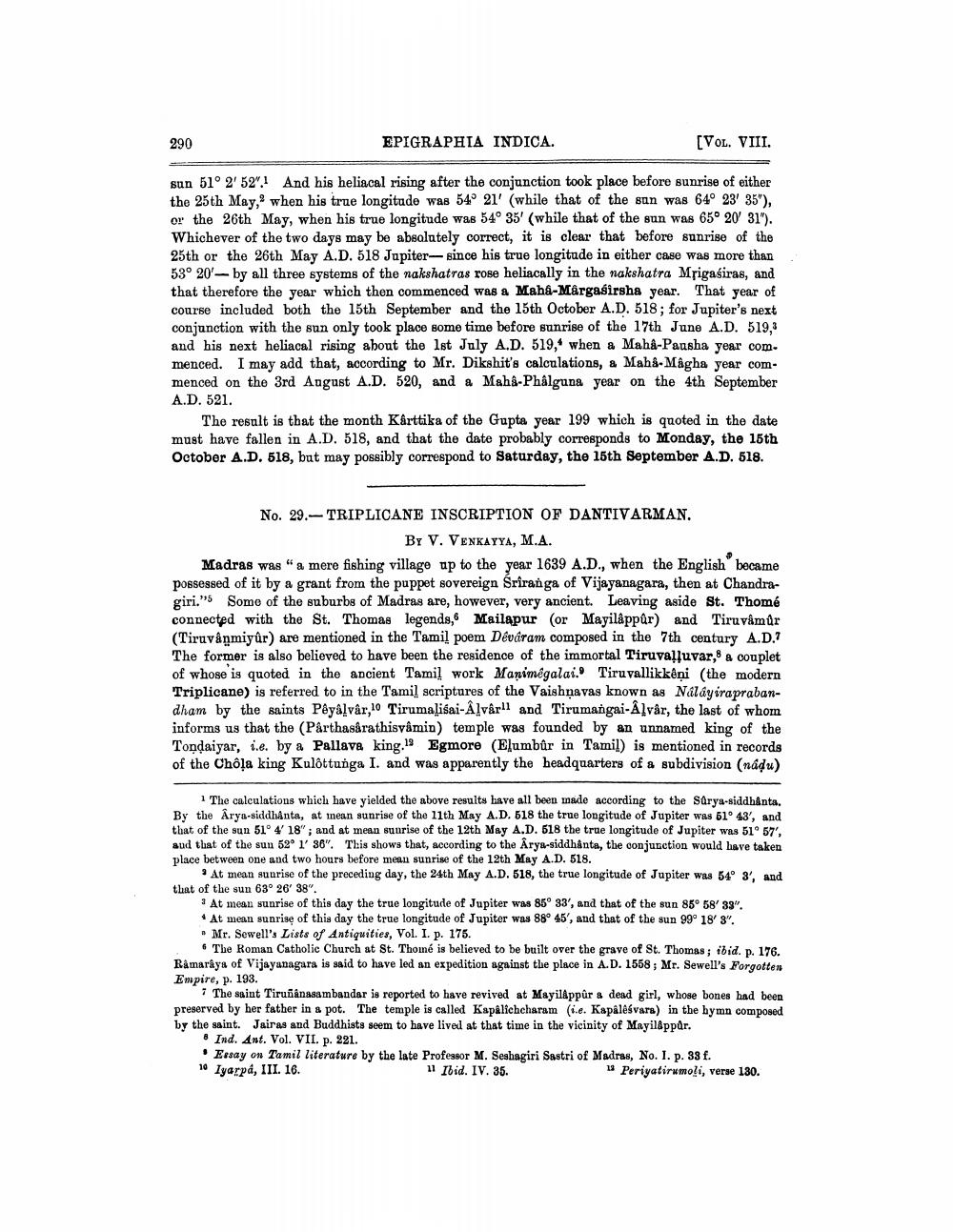________________
290
EPIGRAPHIA INDICA.
(VOL. VIII.
sun 51° 2' 52". And his heliacal rising after the conjunction took place before sunrise of either the 25th May, when his true longitude was 54° 21' (while that of the sun was 64° 23' 35"), or the 26th May, when his true longitude was 54° 35' (while that of the sun was 650 20 31"). Whichever of the two days may be absolutely correct, it is clear that before sunrise of the 25th or the 26th May A.D. 518 Japiter- since his true longitude in either case was more than 53° 20' by all three systems of the nakshatras rose heliacally in the nakshatra Mrigasiras, and that therefore the year which then commenced was a Maba-Mârgaśirsha year. That year of course included both the 15th September and the 15th October A.D. 518; for Jupiter's next conjunction with the sun only took place some time before sunrise of the 17th June A.D. 519, and his next heliacal rising about the 1st July A.D. 519, when a Mahâ-Paasha year com. menced. I may add that, according to Mr. Dikshit's calculations, a Maha Mágha year commenced on the 3rd August A.D. 520, and a Maha-Phâlguna year on the 4th September A.D. 521.
The result is that the month Karttika of the Gupta year 199 which is quoted in the date must have fallen in A.D. 518, and that the date probably corresponds to Monday, the 15th October A.D. 518, but may possibly correspond to Saturday, the 15th September A.D. 518.
No. 29.-TRIPLICANE INSCRIPTION OF DANTIVARMAN.
By V. VENKAYYA, M.A. Madras was " a mere fishing village ap to the year 1639 A.D., when the English became possessed of it by a grant from the puppet sovereign Sriranga of Vijayanagara, then at Chandragiri."5 Some of the suburbs of Madras are, however, very ancient. Leaving aside St. Thomé connected with the St. Thomas legends, Mailapur (or Mayilappur) and Tiruvamur (Tiruvanmiyûr) are mentioned in the Tamil poem Devaram composed in the 7th century A.D. The former is also believed to have been the residence of the immortal Tiruvalluvar, a couplet of whose is quoted in the ancient Tamil work Manimegalai. Tiruvallikkêni (the modern Triplicane) is referred to in the Tamil scriptures of the Vaishṇavas known as Naldycraprabandham by the saints Peyalvar,10 Tirumaliśai-Alvårll and Tirumangai-Alvår, the last of whom informs us that the (Parthasårathisvamin) temple was founded by an unnamed king of the Tondaiyar, i.e. by a Pallava king. Egmore (Elumbur in Tamil) is mentioned in records of the Chola king Kulôttunga I. and was apparently the headquarters of a subdivision (nádu)
1 The calculations which have yielded the above results have all been made according to the Sarya-siddhanta. By the Arya-siddhanta, at inean sunrise of the 11th May A.D. 518 the true longitude of Jupiter was 51° 43', and that of the sun 51° 4' 18'; and at mean suurise of the 12th May A.D. 518 the true longitude of Jupiter was 51° 57', aud that of the sun 52° 1' 36". This shows that, according to the Arya-siddhanta, the conjunction would have taken place between one and two hours before mean sunrise of the 12th May A.D. 518.
. At mean suurise of the preceding day, the 24th May A.D. 518, the true longitude of Jupiter was 54° 8', and that of the sun 63° 26' 38".
? At mean sunrise of this day the true longitude of Jupiter was 85° 33', and that of the sun 85° 58' 33".
At mean sunrise of this day the true longitude of Jupiter was 88° 45', and that of the sun 99° 18' 3".
Mr. Sewell's Lists of Antiquities, Vol. I. p. 175.
. The Roman Catholic Church at St. Thomé is believed to be built over the grave of St. Thomas; ibid. p. 176. Râmaraya of Vijayanagara is said to have led an expedition against the place in A.D. 1568; Mr. Sewell's Forgotten Empire, p. 193.
7 The saint Tiruñánasambandar is reported to have revived at MayilAppúr a dead girl, whose bones had been preserved by her father in a pot. The temple is called Kapalichcharam (ie. Kapalesvars) in the hymn composed by the saint. Jairas and Buddhists seem to have lived at that time in the vicinity of Mayilppur.
• Ind. Ant. Vol. VII. p. 221.
Essay on Tamil literature by the late Professor M. Seshagiri Sastri of Madras, No. I. p. 33 f. 10 Iyarpa, III. 16.
11 Ibid. IV. 35.
1 Periyatirumoli, verse 130.




